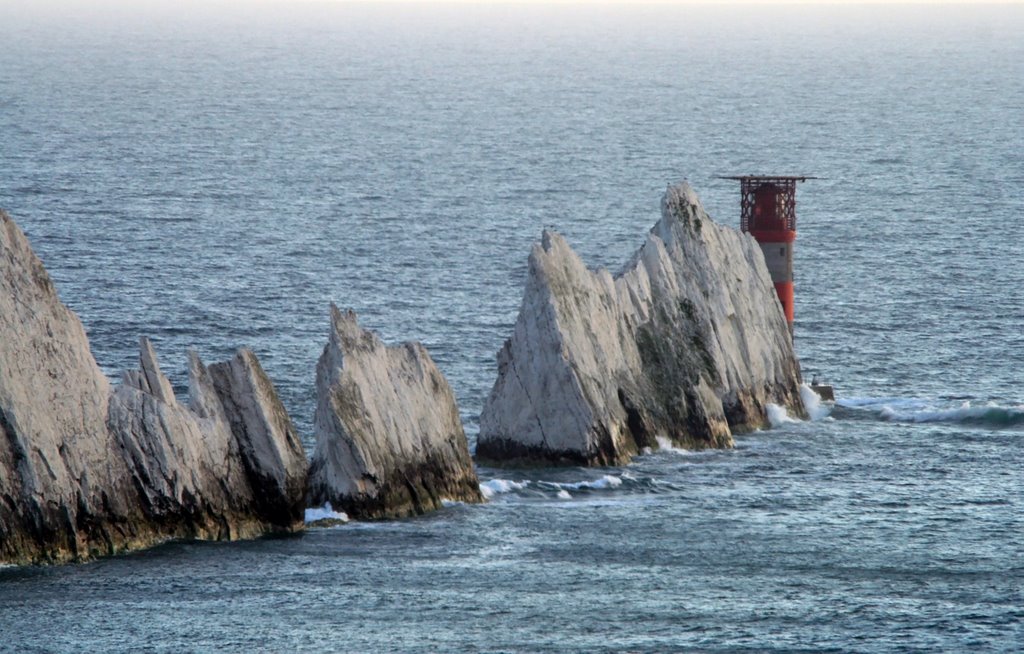
More sea stacks! These are the Needles, made of chalk, rising out of the sea near the western tip of the Isle of Wight in England. A lighthouse stands at right. The Needles got their name from a needle-shaped pillar called Lot's Wife that was part of this formation until it collapsed in a storm in 1764. And they got their pointed shape because these strata of chalk were so heavily folded during the Alpine Orogeny that they're almost vertical!
They're famous, but I first learned about the Needles from Rupert Wood, who mentioned them when we were talking about Durdle Door. He wrote: "The geology of this bit of the UK is pretty crazy. Go west a bit and you encounter Chesil Beach - an offshore shingle beach that stretches for 29km: http://en.wikipedia.org/wiki/Chesil_Beach. Go east and, past the Old Harry sea stacks, skip across the idyllic Bournemouth Bay and you have the iconic Needles, the chalk sea stack denoting the western tip of the Isle of Wight."
Kevin Clift wrote: "The Needles used to be well known in America. For transatlantic travelers they were once the logical equivalent of The Statue of Liberty at the opposite end of the journey. Most liner travel from Northern Europe to the USA was from Southampton. (Some journeys were only one way - the Titanic sailed from Southampton.)"
This nice photo was taken by Andy Wilson, and it appears on Panoramio.
December 23, 2011
In just two days I'll be in Sathalanalat Paxathipatai Paxaxon Lao,
also known as the Lao People's Democratic Republic, or simply Laos.
One of the cool things in Laos that I will not see is the Plain of Jars: an area littered with thousands of enormous stone jars dating back to the Iron Age. Nobody knows what they were for! One theory is that they were used for burials. Local legends claim a race of giants lived there.
December 24, 2011
Today Lisa and I flew to Bangkok together with Prasenjit Duara and
his wife and daughter. We'll spend the night here at the Convenient
Grand Hotel and then continue to Laos tomorrow.
Here's a statue of Vishnu in the Bangkok airport. I like the contrast of mythic and high-tech:
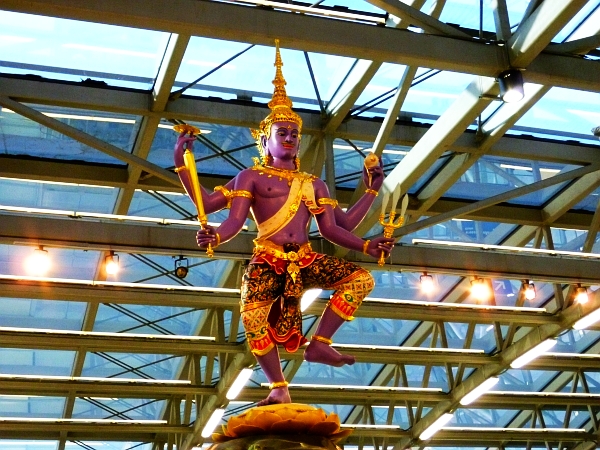
He's prancing atop a famous scene from Hindu mythology: the Churning of the Ocean of Milk, in which the demigods (devas) and demons (asuras) pulled back and forth on a giant snake (the king of nāgas), who was wrapped around a mountain, which rotated and churned the the Milky Way, creating the nectar of immortality — which only the devas wound up getting, thanks to a sneaky trick.
There's also a great bas-relief of this scene in Angkor Wat, which you can see here.
In Hindu cosmology, the Milky Way, or 'Ocean of Milk', is the fifth of
7 oceans that 'surround directional space and separate it from
non-directional space'. I don't know what that means, but it sure
sounds cool! I think some crackpot physicists are actually trying to
write new myths.
December 25, 2011
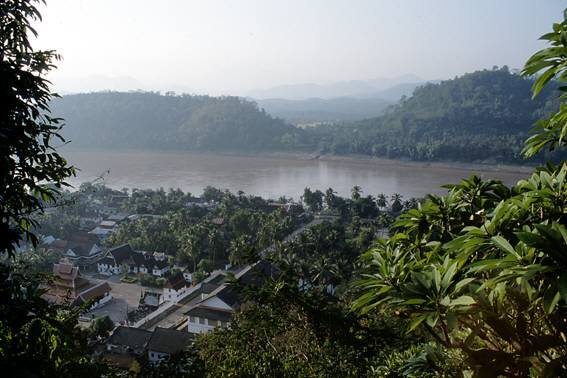
Today Lisa and I flew to Luang Prabang, a wonderful old town in Laos where the Nam Khan river joins the Mekong:
The Duaras and two friends of theirs went to Vientaine, the capital of Laos. They'll join us in two days.
We planned our trip to Luang Prabang very late, and we couldn't find a decent hotel until we had the idea of searching in French. Laos was first a French protectorate and then part of French Indochina until 1953. It still shows in the architecture, the little crêpe stalls, the baguettes and croissants, and the large number of French tourists. We wound up in the Hotel Villa Deux Rivières, a wonderful place near the tip of the peninsula where the rivers meet. This part of town is a bit away from the tourist epicenter — nice and quiet except when the monks pound the early morning wake-up drum at the nearby Wat Xieng Thong.
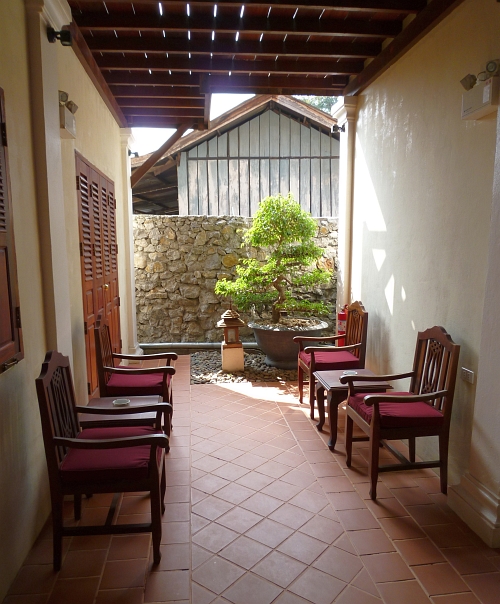
Walking out of the hotel we saw some rice cakes drying outdoors in a nearby alley:
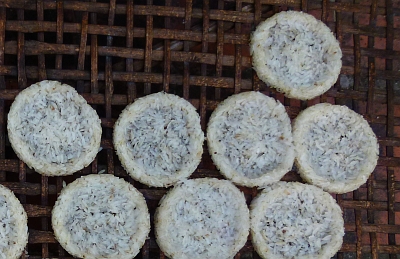
We never saw these served anywhere — but sticky rice called khao niao was omnipresent, usually served in a special basket with the lid attached to the body by strings:
The rice is cooked a long time so the starch dissolves a bit, making it very sticky — but it's fairly dry, not mushy, so people can easily eat it with their hands (or more precisely, their right hand).
Wat Xieng Thong, built around 1550, dominates the tip of the peninsula on which Luang Prabang is built. It has a long stairway leading down to the Mekong, and it was considered the entrance to the city.
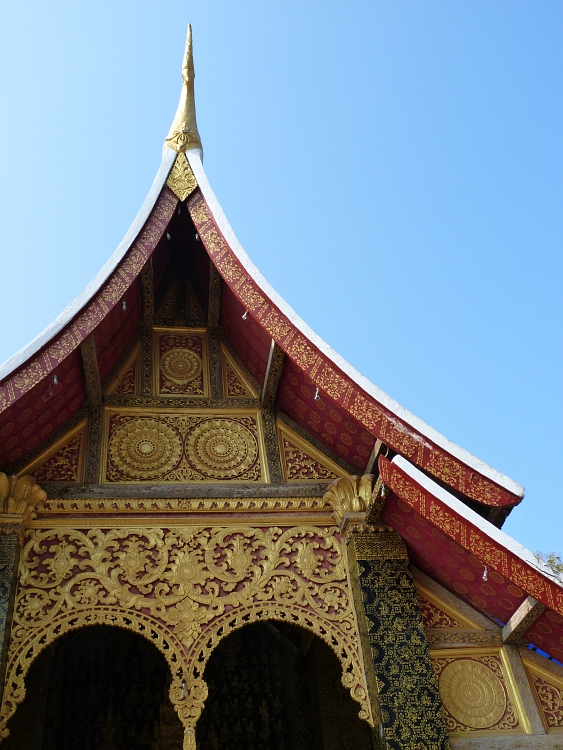
This is just one of many buildings there, but it's the most important: it's the sim, or assembly hall. The pointy spire, gold trim and overlapping roof layers are distinctively Lao.
Here's a closeup of the front wall of the sim at Wat Xieng Thong. Patterns are drawn in gold paint using stencils:
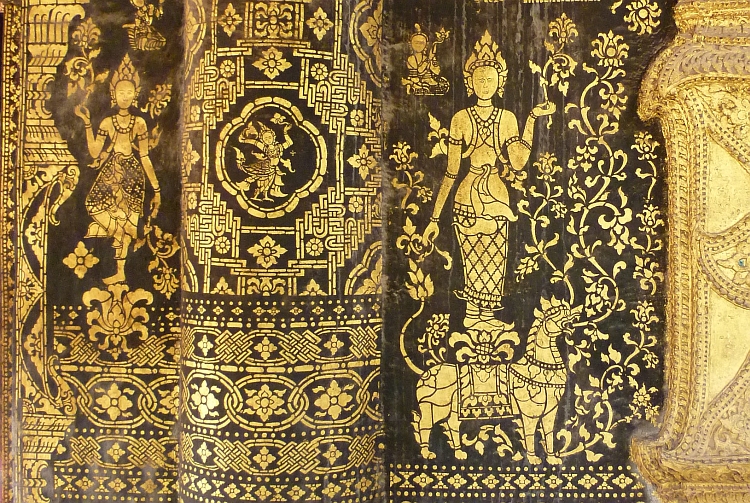
Here's a detail from inside the assembly hall at Wat Xieng Thong:
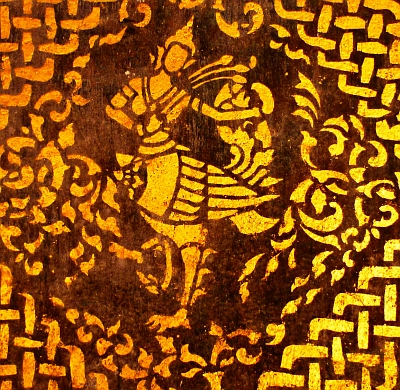
Thanks to Denise Heywood's excellent book Ancient Luang Prabang, I learned this is a kinnara. Renowned for its dance, song and poetry, it's a symbol of feminine beauty, grace and accomplishment. But there's also a male version, called a kinnara. These creatures are popular throughout southeast Asia wherever Buddhist or Hindu mythology holds sway — from Indonesia through the Khmer Empire (though I missed them at Angkor) all the way across India and on up into Tibet!
In the Mahabharata, the kinnari and kinnara say:
We are everlasting lover and beloved. We never separate. We are eternally husband and wife; never do we become mother and father. No offspring is seen in our lap. We are lover and beloved ever-embracing. In between us we do not permit any third creature demanding affection. Our life is a life of perpetual pleasure.
In Burma, Buddhists believe that out of the 136 past animal lives of Buddha, 4 were spent as kinnara.
Here's a detail from the Chapelle Rouge at Wat Xieng Thong:
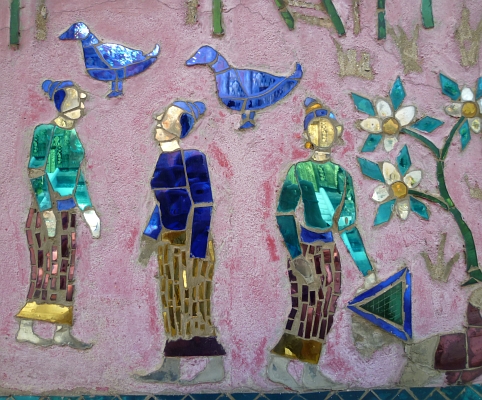
This goes back all the way to... 1960. But in fact all the wat in Laos are continually renewed and rebuilt, somewhat to the annoyance of western romantics who love a good ruin.
This looks like a mammoth artichoke — but no! It's a statue of a lotus bud outside the sim of Wat Xieng Thong:
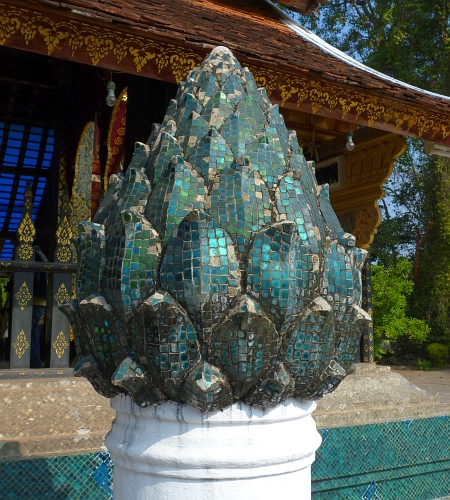
The lotus plays a big role in Hindu and Buddhist symbolism. It represents the "blossoming of purity in blissful liberation from the muddy waters of attachment and desire".
December 26, 2011
Laos is a landlocked, hilly country where until recently river transportation was more important than the rugged unpaved roads. The mighty Mekong reigns supreme, and it goes through the capital Vientiane but also the historically important city of Luang Prabang, which sits where the smaller Nam Khan River flows into this giant.

Know this flower? It's also big in Southern California. But it's not really a flower! It's called a bougainvillea — and those purple things are actually leaves, or more precisely, bracts! They get nice and colorful when the soil gets dry — and the dry season in Laos runs from November to May, so it's delightfully cool and dry here now. May to July is the monsoon, with heavy rains.
Oddly this weather pattern is the opposite of Singapore, where the heaviest rains start in November (but it's hot and rainy year-round). I haven't figured out much about southeast Asia yet — not even the weather! But my trip to Laos is helping me fill in some of the puzzle.
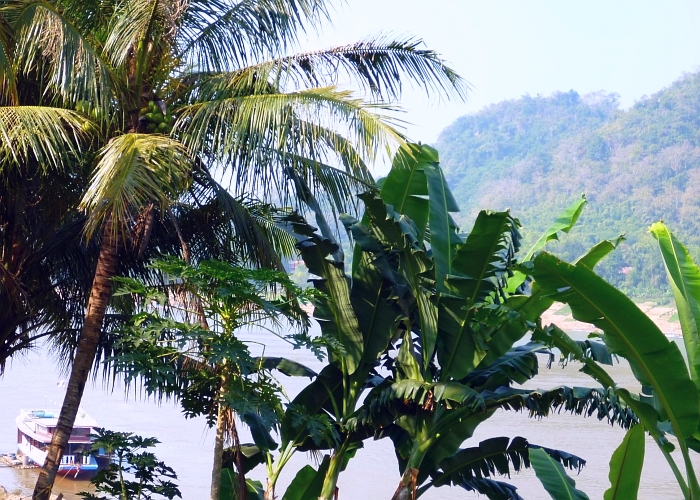
The people of Laos are famous for their laid-back, friendly attitude. Strong emotions and stress are avoided, and success is often attributed to karma rather than hard work. Some of this comes from Theravada Buddhism, which emphasizes suffering, impermanence and the illusory quality of everything. The cure for all this is nirvāna, the 'blowing out' of the fires of craving. While all this may seem esoteric, it's probably not, especially here in Luang Prabang — the country's religious center, with over 47 wat, or temples.
The flip side of this disinterest in reality may be that Laos is one of the poorest countries on earth, with more than 75% of the people living on less than $2 a day. Free education is provided up to 5th grade, but only the larger villages have high schools. Many boys who want further education become monks, often just temporarily as 'novitiates'. (Some girls become nuns, but so far my impression of Theravadan Buddhism as practiced in southeast Asia is that it's very sexist.) I saw a bunch of novitiates in a physics class learning how to solve harmonic oscillator problems in a wat near the hill at the center of town. I can't read Lao, but 1/2π times the square root of k/m means the same thing worldwide!
Here's something you never see in the US!

In tourist havens like Luang Prabang, shops supply almost any good you'd want, and small businesses seem to be doing well, but ownership of land is not allowed, and Laos is a one-party state, with many of the problems that usually entails. All newspapers in Laos are published by the government — but even more oddly, I've never actually seen one in the stores here! Nor have we seen a store selling books in the Lao language. I've also heard of big military processions in Laos that nobody bothers to attend. More examples of the uniquely laid-back nature of the Lao?
An acquaintance asked novitiates at a monastery here if they knew Osama bin Laden had been killed, and they didn't know anything about the whole business. Their physics textbook was, I believe, written in Thai — although I didn't carefully check. Luckily, the languages are so similar that the Lao monks can understand spoken or written Thai. Thai TV channels flood into Laos, and are widely watched.
Laos is not only poorer than Vietnam and Cambodia, it also has a weaker national identity. About 60% of the people are ethnically Lao, mostly in the lowlands. About 30% are Mon and Khmer people, related to the Burmese and Cambodians respectively, mainly living in the southern and central mountains. And about 10% are a mix of Hmong, Yao, Dao, Shan, and several Tibeto-Burman tribes, who have mostly been pushed up into the higher northern mountains.
Western technology and global politics must have come as a big shock to these folks when the French took over in 1893 — not to mention when the US started bombing Laos in 1964. We dropped an average of one B-52 bombload on them every 8 minutes, 24 hours a day, for a whole decade. The goal of this so-called 'Secret War' was to harass the communist North Vietnamese in Laos. It's the most heavily bombed country in the world.
The Hmong are famous for supporting the US in this conflict, and they've had a rough time in Vietnam and Laos ever since. The day after Christmas, we met a guy who'd gone to a Hmong festival on the outskirts of Luang Prabang the previous night. He said it would still be going on, and was worth checking out. He said to get a tuk-tuk driver and bargain him down to 30,000 kip (about $3.70) for a one-way ride. We wound up hiring a tuk-tuk driver for a round trip for 70,000 kip.
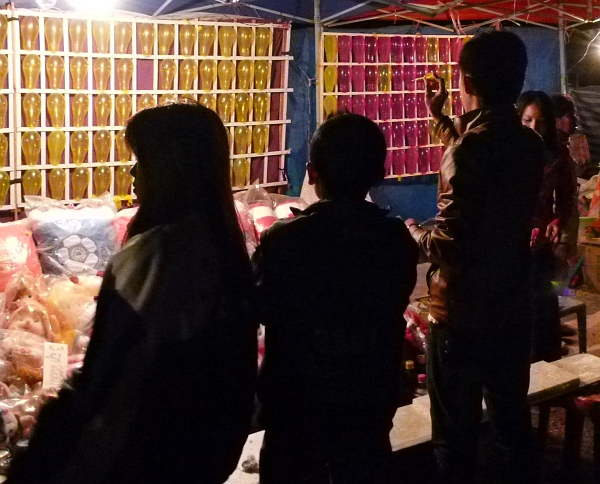
We were told we'd see people wearing traditional Hmong garb; instead,
masses of kids in Western dress were playing various games. A popular
one lets you pay to get three tries throwing darts at balloons. If you
pop all three, you get a stuffed animal. The average age in Laos is a
bit over 19 — and here that was very clear.
December 27, 2011
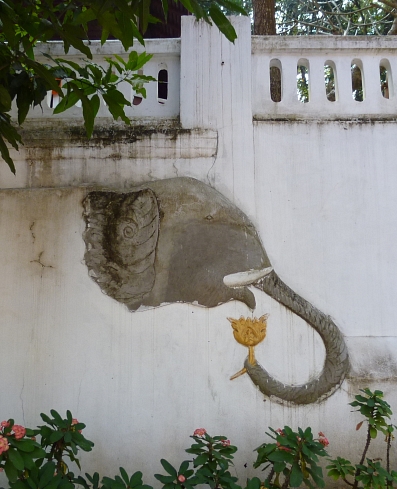
I saw this painting on a wall near Wat Pa Khe, a Buddhist temple at the foot of the big hill called Phu Si in Luang Prabang — the same temple where I saw monks learning about harmonic oscillators.
The country of Laos traces its roots back to the kingdom of Lan Xang, which means Land of a Million Elephants. This romantic name refers to the formidable army led by a prince from Angkor, who invaded in 1354 and later set up his capital at Luang Prabang. Elephants were used roughly as tanks are now. There are now about 2000 elephants in Laos, 800 in the wild and the rest domesticated, often used for labor. That doesn't sounds like many, but Laos is the country with the sixth biggest population of Asian elephants.
You can ride an elephant in village near Luang Prabang, and even learn a bit about how to be a 'mahout', or elephant handler — but I didn't do it.
Here's what southeast Asia was like around 1400 AD:
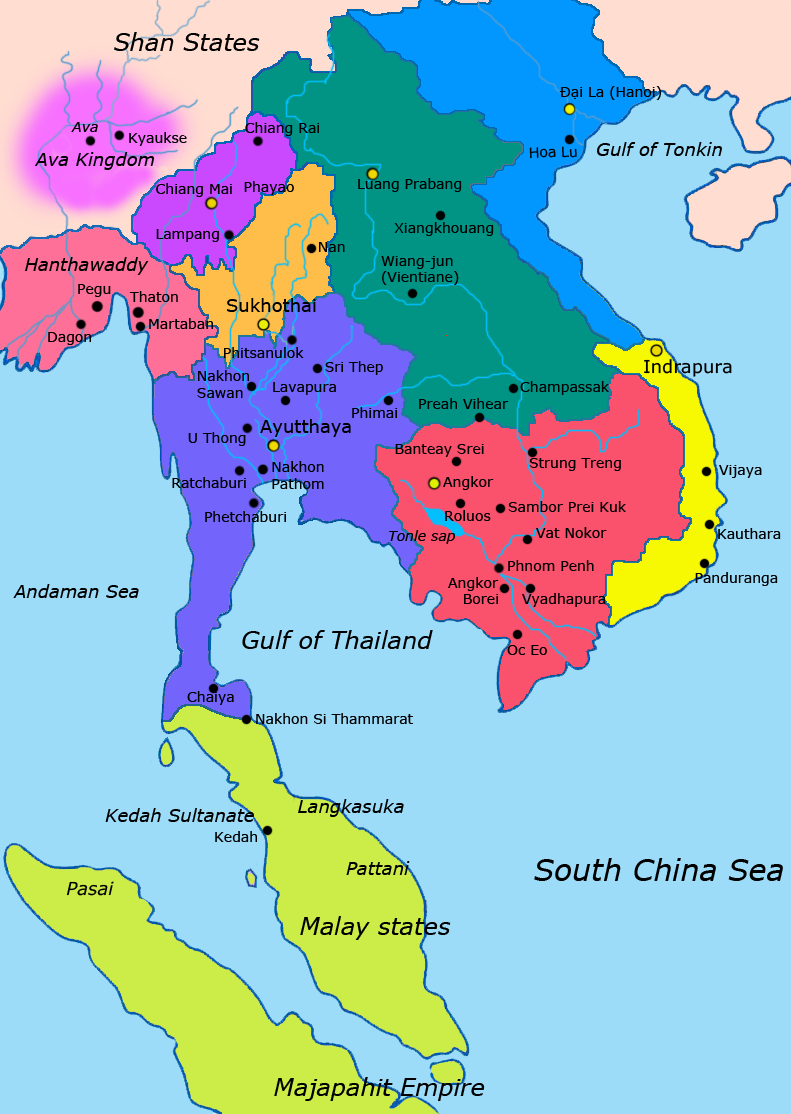
In green you can see Lan Xang and its capital Luang Prabang. To the south in red we see the Khmer Empire, whose capital was Angkor. East of that, in yellow, is the kingdom of Champa. When I visited Vietnam, I saw some great Hindu sculptures from there! To the west, in indigo, is the kingdom of Ayutthaya, also known as Siam. North of that, orange, is the kingdom of Sukhothai, which I know nothing about! There are also others.
I'm just starting to get a sense of how these places fit together, and
how Sanskrit, Hinduism, and Buddhism spread over the whole region. At
first it all seemed like a hopeless blur. Now I know just enough to
start getting curious.
December 28, 2011
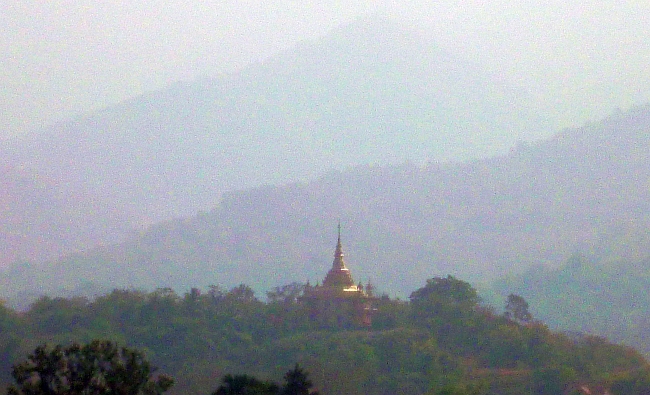
Almost everyone who visits Laos falls in love with the wat, or temples — they seem to be built for flight, like wings or missiles. The orange robes of the monks are also incredibly eye-catching and charismatic. But beneath these very visible signs of Theravada Buddhism, there's a layer of animism that pervades Lao culture. This was hard for a casual visitor like me to detect, except in the little 'spirit huts' that dot the landscape. But according to Wikipedia:
Despite the importance of Buddhism to Lao Loum and some Lao Theung groups, animist beliefs are widespread among all segments of the Lao population. The belief in phi (spirits) colors the relationships of many Lao with nature and community and provides one explanation for illness and disease. Belief in phi is blended with Buddhism, particularly at the village level, and some monks are respected as having particular abilities to exorcise malevolent spirits from a sick person or to keep them out of a house. Many wat have a small spirit hut built in one corner of the grounds that is associated with the phi khoun wat, the beneficent spirit of the monastery.Phi are ubiquitous and diverse. Some are connected with the universal elements — earth, heaven, fire, and water. Many Lao Loum also believe that they are being protected by khwan (thirty-two spirits). Illness occurs when one or more of these spirits leaves the body; this condition may be reversed by the soukhwan — more commonly called the baci — a ceremony that calls all thirty-two khwan back to bestow health, prosperity, and well-being on the affected participants. Cotton strings are tied around the wrists of the participants to keep the spirits in place.
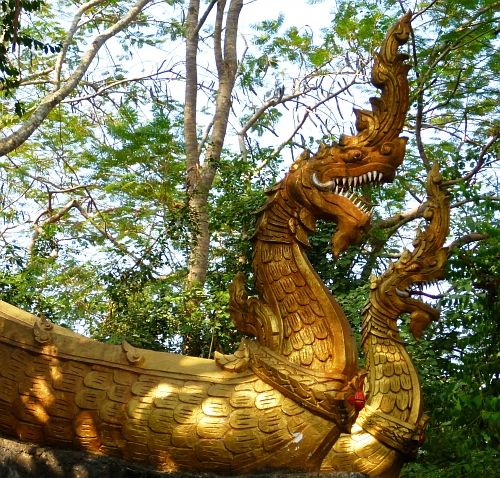
Here are two nāga statues on top of Phu Si, the big hill that dominates Luang Prabang. Snake-like river spirits called nāga seem to be important in all the lands of southeast Asia that have been touched by Hinduism. I've already shown you some images of them from Cambodia, and they seem even more popular in Laos. People along the Mekong river seem to really believe in them! Quoting Wikipedia:
The legend of the Nāga is a strong and sacred belief held by Thai and Lao people living along the Mekong River. Many pay their respects to the river because they believe the Nāga still rule in it, and locals hold an annual sacrifice for the Nāga. Each ceremony depends on how each village earns its living from the Mekong River — for instance, through fishing or transport. Local residents believe that the Nāga can protect them from danger, so they are likely to make a sacrifice to Nāga before taking a boat trip along the Mekong River.Also, every year on the night of 15th day of 11th month in the Lao lunar calendar at the end of Vassa, an unusual phenomenon occurs in the area of the Mekong River stretching over 20 kilometres between Pak-Ngeum and Phonephisai districts in Nong Khai province, Thailand. Fireballs appear to rise from the river into the nighttime sky. Local villagers believe that Nāga under Mekong River shoot the fireballs into the air to celebrate the end of Vassa, because Nāga meditate during this time.
A photograph on display in bars, restaurants, guesthouses, and markets around Thailand captioned Queen of Nagas seized by American Army at Mekhong River, Laos Military Base on June 27, 1973 with the length of 7.80 meters is a hoax. The photograph is actually that taken by USN LT DeeDee Van Wormer, of an oarfish found in late 1996 by US Navy SEAL trainees on the coast of Coronado, California.
© 2011 John Baez
baez@math.removethis.ucr.andthis.edu